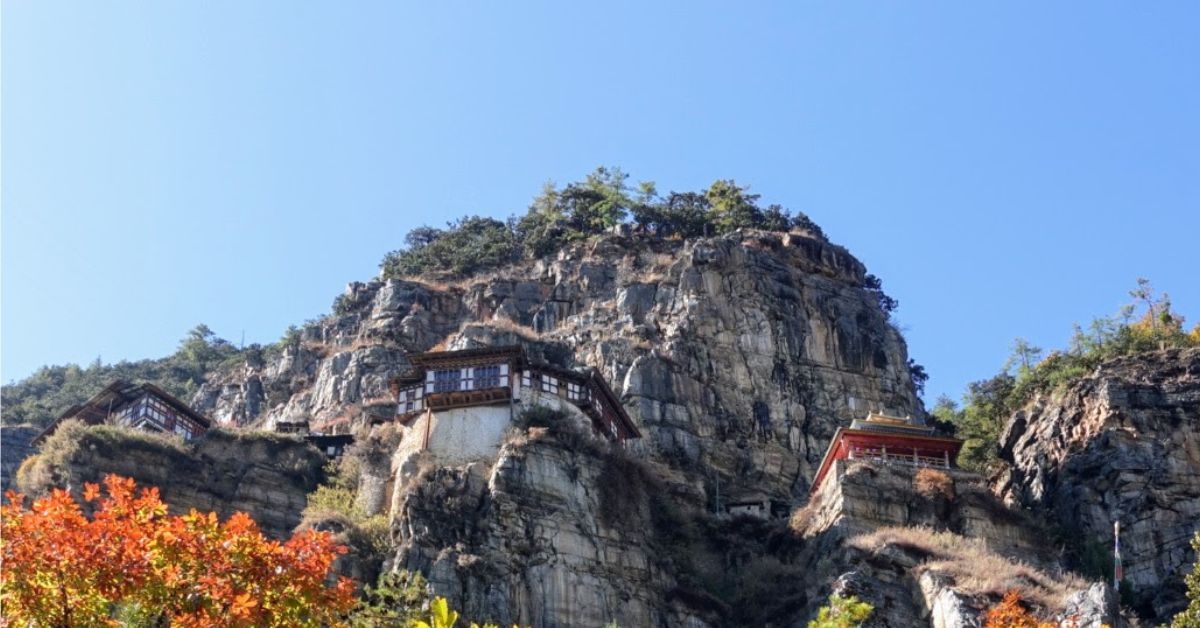Dzongdrakha Goenpa is a sacred cliff of Guru Rinpoche above the two villages of Bonday and Gyepjag under Paro Dzongkhag, blessed during his second visit to Bhutan in 822 A.D from Tibet. This sacred Dzongdrakha Goemba is located at an altitude of 1400 meters above sea level.
Later, Drupthob Gonpo Dorji built a Lhakhang and named it Dzongdrakha Goenpa. Dzongdrakha Monastery is often called the Second Taktsang, mainly due to its location setting as it is perched on a cliff-side on the western side of Paro Valley. This visually splendid but seldom visited Dzongdrakha Goemba is worth a short detour off the Paro–Cheli La road.
How to Reach Dzongdrakha Goenpa
Dzongdrakha Lhakhang is a 20-minute drive from Paro International Airport toward the Paro-Haa highway. Dzongdrakha is located under Lungnyi Gewog of Paro dzongkhag. From the road end, you must walk through some historic homes for an additional 15 minutes.
Dzongdrakha Hike: Nature enthusiasts can choose to hike to the monastery. The hike is not as strenuous as Paro Taktsang. Reaching the monastery requires a 40-minute walk through the forest of rhododendrons and oak trees. The breathtaking views of the valley it surrounds will undoubtedly captivate you. Hiking to Dzongdrakha Gompa is a favored thing in Paro apart from the Tiger’s Nest trek.
Sacred Relics to See at Dzongdrakha Monastery
- A crystal stupa (chorten) which is as long as an arrow;
- Egg-shaped relic of Sangay Youelsum (Karshapa);
- Meditation cave of Drubthob Gonpo Dorji;
- Immovable statue of Buddha Sakyamuni;
- Sacred dagger marks on a stone.
Also Read: Guru Rinpoche in Bhutan: His Visits to Bhutan and Sacred Sites
Historical Significance of Dzongdrak
Guru Rimpoche is said to have flown to the sacred site from Drak Karpo in Paro just above Shaba in the 8th century. One can still see the footprints of Guru Rinpoche at the base of the cliff.
In the later part of the 13th century, Karzhi Rinchen Samten Pelzang had a dream in which a Khandrom gave him instructions to travel to Zhungphug in Bhutan, where the treasures of Guru Rinpoche were concealed. Lam Karzhi then shared his dream with a disciple, Drupthob Gonpo Dorji, who later followed the instruction given to Lam Karzhi Rinchen Samten Pelzang.
Drubthop Gonpo Dorji then proceeded to Bhutan in 1428 in search of a place called Zhungphug in Paro. When Drubthob arrived at a riverside and was unsure of where to go, a jackal pointed to Zhungphug. The Drubthob and the jackal followed the river’s right bank.
Finally, before reaching Dzongdrakha, the Lama reached a small plain where he encountered a female goat. The Lama later realized that the goat was no other than the riding horse of Damchen Dorji Lekpa, the deity of Dzongdrakha, and considered it a promising sign to proceed toward the sacred cliff. The Dupthob Gonpo Dorji started his meditation as soon as he arrived in Dzongdrakha.
The Discovery of Relics
While Drubthop was meditating, Guru Rinpoche gave him a crystal sword. The sword became fixed on a rock that resembled a male donkey and a frog. The rock with the sword stuck on it rolled towards him. Inside the rock, the Lam came across a crystal Chorten measuring the length of an arrow, a Ringsel (body relic of Sangay Youelsum) of Buddha Kasyapa, and three Garuda eggs. Two of the three eggs are claimed to have flown away.
Drubthop Gonpo Dorji then took the crystal chorten, the Ringsel, and the remaining egg in a sack and reached a valley and sought shelter in a farmer’s house. Knowing about the treasure in the sack, the locals claimed ownership of the relics. As a result, the valley acquired the name “Bangdey,” now known as “Bondey.”
Later, he returned to Dzongdrakha and built a chorten on a cliff that resembled a lion. The chorten was named Shel (Crystal) chorten. Inside the chorten, he placed the crystal chorten, the Ringsel, and the egg. Dubthob Thangtong Gyalpo, on a visit to Dzongdrakha, consecrated the chorten.
Description of Dzongdrakha Goenpa
Dzongdrakha Temple, also known as Mini Taktsang, is a serene site above the Bondey village on the western side of the Paro Valley.
The first building you visit is the private manor house of Jongsarbu Lhakhang, founded in the 18th century by Drubthob Gonpo Dorji. Drubthop installed the treasures (egg-shaped relic of Sangay Youelsum and the crystal stupa) as a sacred monument inside it and named it Dzongdrakha Goenpa. The crystal stupa was given the name Chorten Karmogyel because it is said that the relic used to tremble on lucky days.
The main statue Dzongdrakha Lhakhang is Sakyamuni in his princely Jowo form, flanked by the local protector Tsento Chen and a tshomen (mermaid). Dorji Legpa is the deity of the Lhakhang, who protects the Lhakhang and the sacred monument inside it.
The Drubthop, who had spent all his life in this Lhakhang, ultimately died there. Visit the cave where Drubthop Gyonpo Dorji has meditated.
Dzongdrakha Monastery
After the death of Drubthop, his reincarnation started the lineage of Dzongdra Chhoeje, and many Lhakhangs and monasteries were built in and around the place.
In the 14th century, his reincarnation, Lam Neten Jangchub Zangpo, built a temple dedicated to Guru Padmasambhava. On the right side of the chorten is the temple of the three Buddhas built by the reincarnation Lama Phan Thog.
The Dzongdrakha monastery was built by Choejay Penjor, son of Choejay Dawa, the reincarnation of Drupthop Goenpo Dorje. The Dzongdrakha monastery houses four shrines devoted to Tara, Tsheringma (Goddess of Longevity), Guru Rinpoche, and the Buddha of the Future, Jowo Jampa.
To the left of the Chorten is the Tsheringma Lhakhang, the temple of the female Goddess Tashi Tsheringma (Goddess of Long Life). In the Tsheringma Lhakhang are the statues of Tsheringma and Lord Buddha.
Next to Tashi Tsheringma temple is the temple dedicated to Sangay Mithrukpa (Akshobya). Lam Rabten and Lam Phan Thog built this.
In Guru Lhakhang, the lama will open a small door behind the main statue to reveal part of the secret chorten, which is caged to keep it from flying away. The main relics of Dzongdrakha Lhakhang are an egg-shaped relic of Sangay Youelsum (karshapa) and a crystal stupa (Chorten) that is as long as an arrow. There is a statue of two Khandroms and the statues of the eight manifestations of Guru Rimpoche.
To access the cave-like Droley Lhakhang, which houses the neighborhood protectors Doley and Shari Tsen, originally employed during local celebrations, climb the rickety log ladder behind the temple. It is customary for local parents who have recently given birth to a son to visit this temple to get a fortunate name for their child. The little Lhamey Lhakhang is the last structure.
Dzongdrakha Tshechu Festival
Dzongdrakha Tshechu is held at Dzongdrakha Monastery on the day before and the day after the Paro Tshechu held at Paro Rinpung Dzong. The annual Dzongdrakha Tshechu Festival is performed from the 8th to the 10th days of the 2nd month.
Don’t miss the Wochubi Zhey dance, which was presented at the Dzongdrakha monastery’s initiation ceremony by the residents of Wochu hamlet. Wochubi Zhey is the only Zhey reportedly introduced in Bhutan before Zhabdrung’s arrival. On the last day of Tshechu, observe the distinctive dance of Berkor Cham.
They also have a day-long festival on the 16th day of the 2nd month of the Bhutanese calendar.
Also Read: Paro Rinpung Dzong, the Fortress on a Heap of Jewels
Best Time to Visit Dzongdrakha Temple
Dzongdrakha Temple doesn’t require reservations to visit. Depending on your budget, numerous hotels are available close to Dzongdrakha Temple. Make sure to go when Dzongdrakha Lhakhang celebrates its yearly festival because the main gathering place transforms into the chorten of the previous Buddha, which is then opened so guests may receive blessings from the relic.
If you can’t trek to Tiger Nest, visit Dzongdrakha Goemba once, which is aesthetically just as stunning as Paro Taktsang. You can visit major pilgrimage sites in Paro with the Bhutan Pilgrimage Package.
Enjoyed reading this blog?




